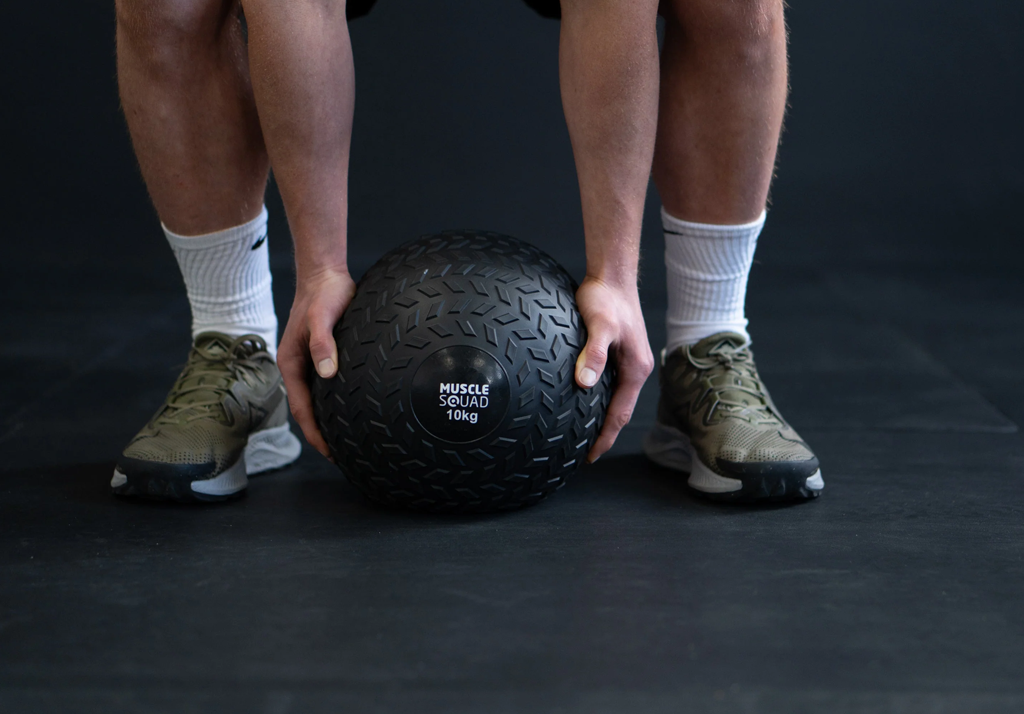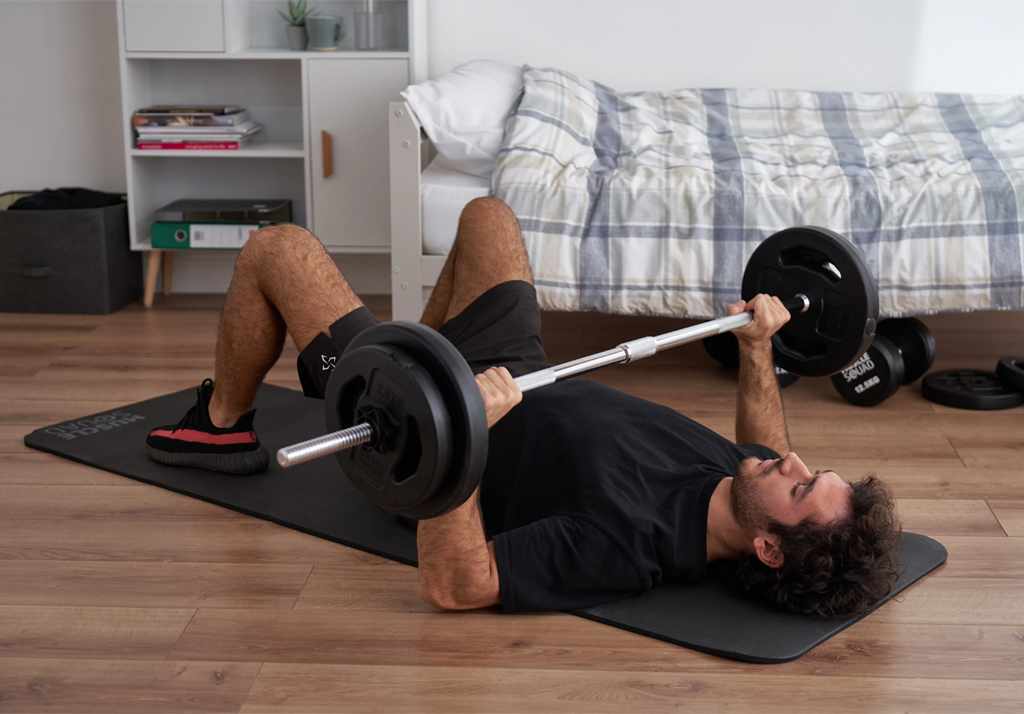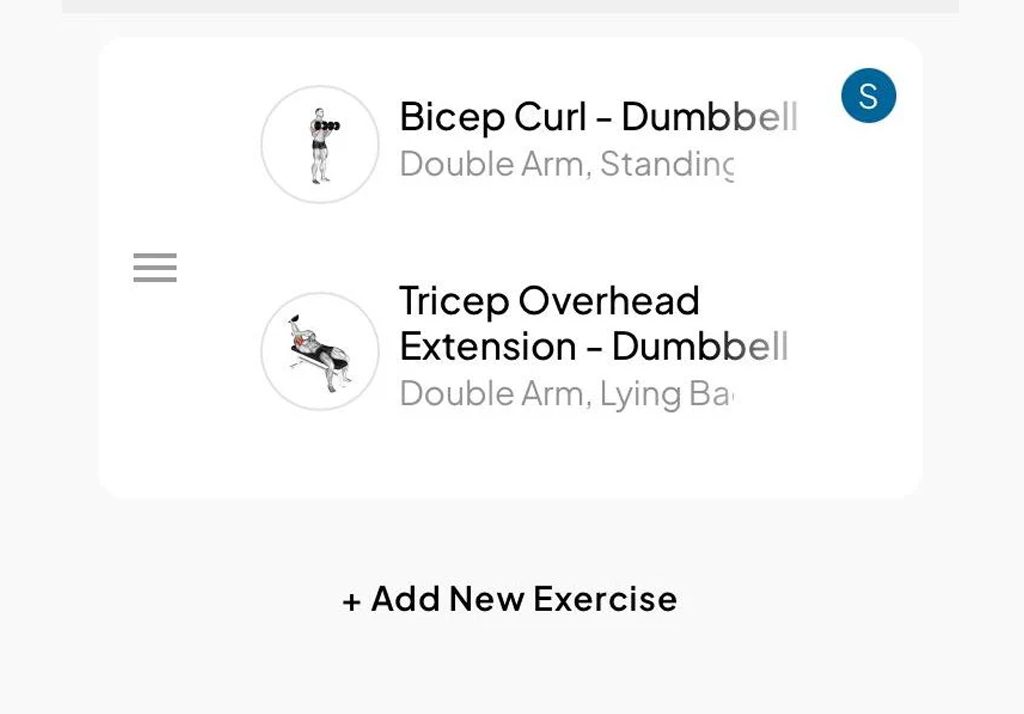The barbell squat (normally known as the squat), is undoubtedly the best exercise to build strength and size in your legs. Not only does it work your quads, but it also targets your glutes and hamstrings, whilst also working your core.
What is a Barbell Squat?
The barbell squat is performed using a loaded barbell. The movement itself is simple. With the barbell resting on your back, you simply squat down and then back up.
The fundamental equipment you need to do a barbell squat is: a barbell, weight plates, and a power rack. The barbell means you can vary the weight you use for your squats; this is done by adding/removing the weight plates. Effectively, a barbell and weight plates act as a giant adjustable dumbbell. You can lower the weight to complete more reps and increase the weight when you are ready to progress as you gain strength.
There are two variations of the barbell squat, known as ‘high-bar’ and ‘low-bar’. Each variation is dependent on where the bar is placed on the user’s back. Beginners should start off with the traditional high-bar variation until they get used to the movement and learn the form.
How to do a High-bar Barbell Squat
Firstly, set the J-Hooks of your power rack to a height just below the top of your shoulders. Then place the empty bar onto the J-Hooks. Make sure your safety arms are set to an appropriate height, ideally just below the lowest point of your squat.
To perform the squat, stand behind the bar and place your hands in a comfortable position on the bar. Usually, this is slightly wider than shoulder-width. Then step under the bar and rest it just below the bottom of your neck, on your traps. If you’re new to the gym, this may be uncomfortable at first, until you build more muscle on the area, so feel free to use a neck pad until you’re ready. Once the bar is in the correct position, stand upright to un-rack the bar, and take a few steps backwards. When you’re in position, your feet should be at about shoulder-width or slightly wider.
Before you descend, take a deep breath, and tense your core. This is known as bracing. A useful way to make sure you’re bracing correctly is to imagine Anthony Joshua is going to punch you in the stomach. Bracing keeps everything tight and helps you to keep a more upright posture during your squat.
Once you’ve braced, bend your knees, and begin to descend. You should aim to move the bar downwards in a perfectly straight line. This is known as the bar path. Try to keep your chest relatively upright, and do not let your back bend. It is important that you keep your spine in a neutral, straight position to avoid injury.
Once you have reached parallel or ‘hit depth’, come back up. The lowest point of your squat should be when the tops of your thighs are parallel with the ground (or lower if you can go lower). This means you’re squatting with a full range of motion, which is ideal for building strength and size. To bring yourself back up, keep your core braced and ‘push the floor away’, driving through your heels. Once your knees are locked out, you’re ready to complete the process again and do another rep.
When your set is finished, take a few steps forward and place the bar back onto the J-Hooks.
How to Low-Bar Squat
Once you’ve mastered the traditional high-bar squat, you may wish to transition to the low-bar variation. Low-bar squats are done mainly by powerlifters who are looking to maximise their strength, rather than building as much size as possible.
What sets the low-bar squat apart from the high-bar squat, is the bar positioning on the user’s back. As we know, high-bar has the bar on your traps. But, low-bar places the bar lower down your back, sitting just above the shoulder blades.
This means the bar does not have to travel as far, so you can move slightly more weight with less effort. When descending from a low-bar squat, lean slightly forward and push your glutes backwards until you get to parallel and drive yourself back upwards.
The low-bar squat is more effective for building strength. If you don’t consider yourself an advanced lifter, or you’re mainly looking to build size and strength, the high-bar squat is the one for you.
How to Squat Deeper
Some people have problems squatting to parallel or below. It’s important that you reach parallel when you squat so that you can reap the benefits of full range of motion. If you can’t get to parallel, there are a few things you can do to help yourself.
Firstly, try turning your feet slightly outwards (about 10-20 degrees) while you squat. This will open up your hips a bit more and will hopefully allow you to get lower.
You can also elevate your heels by placing a 1.25kg plate underneath each of your heels. This means your ankles do not have to flex as much for your knees to get to the parallel position.
The best solution to this problem is to stretch. If you can’t get to parallel, it’s likely that you have poor ankle mobility. To test your ankle mobility, from a kneeling position, place your front foot five inches from a wall. Your toes should measure exactly 5 inches from the wall. Whilst keeping your foot flat on the ground, try to bring your knee forwards and see if you can get it to touch the wall. Test this on both feet. If your knee can’t touch the wall from this position, you have poor ankle mobility, which is stopping you from getting to parallel during your squats.
You can improve your ankle mobility with some simple and easy stretches. Check out this YouTube video from Squat University for more info on this.
What Equipment do I need for Squats?
We’ve already covered the basic need for a barbell, weight plates, and a rack. But what else can you get to help you squat?
- A weightlifting belt will help you to brace, and keep your core and lower back tight during the squat. With a belt, it’s easier to move more weight due to its added security. It essentially helps you squat to your full potential.
- A pair of squat shoes are always a solid investment for serious squatters. They have a slightly raised heel, so your ankles are not under as much pressure. These are great for everyone but especially handy if you have poor ankle mobility.
- Knee sleeves help to give you an added feeling of security in your knees while you squat. They compress your knees and help you to ‘bounce’ upwards once you’ve hit depth. They also help to keep your knees warm when resting in between sets.
- If you squat low-bar, it’s probably worth getting yourself a pair of wrist wraps. As the bar isn’t resting on your traps with this variation, your wrists have to work hard to keep the bar pressed against your upper back. When working with heavier weights, this can be extremely uncomfortable and painful. A pair of wrist wraps will help to minimise this pain so you can focus on squatting with as heavy a weight as you can.
Jamie Grover, Fitness Journalist from Bristol.

 Feb 01, 2022 - Jamie Grover
Feb 01, 2022 - Jamie Grover


Leave a comment: